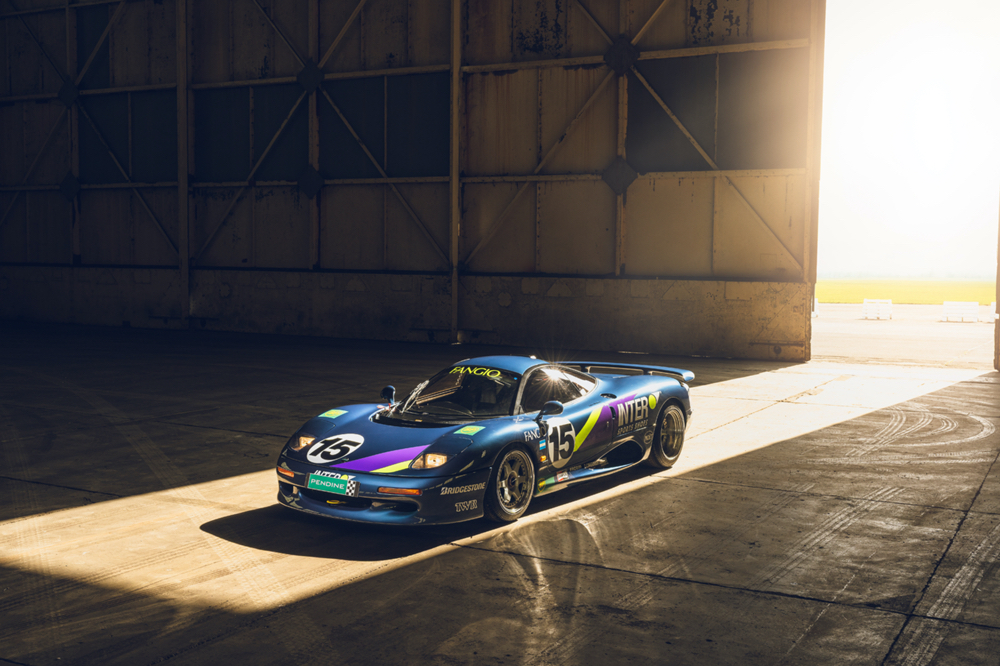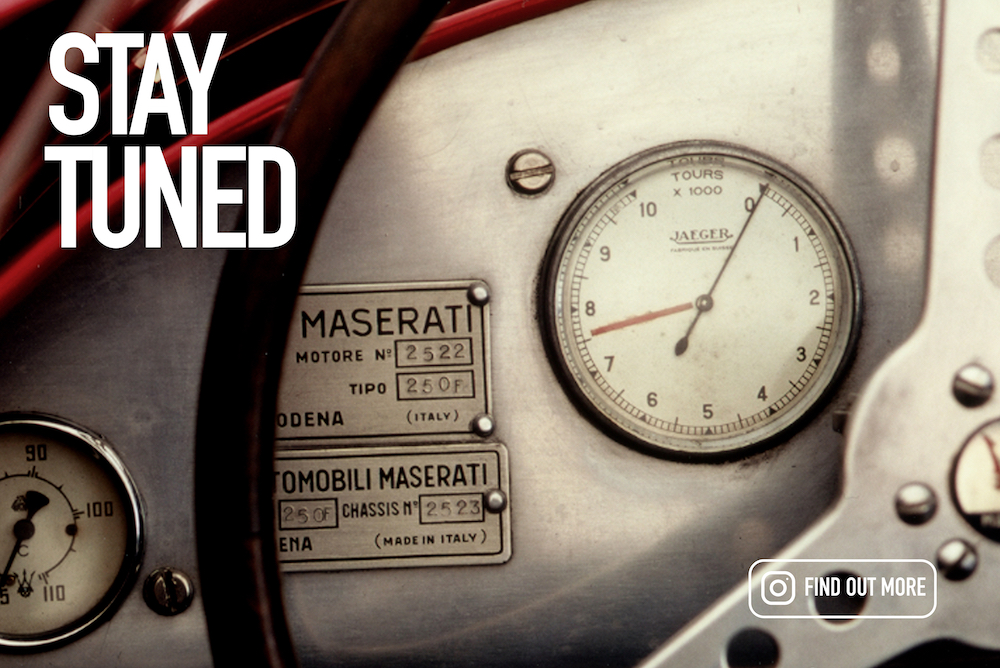Pendine is offering this JaguarSport XJR-15 for sale. 1 of only 16 JaguarSport XJR-15 Race Cars.

1991 JaguarSport XJR-15 Race Car
Chassis no. 048
Engine no. XJR-15-016
Race Car no. 15
Inspired by Jaguar’s 1988 Le Mans victory with the XJR-9LM.
Led by Tom Walkinshaw (TWR) and designed by Peter Stevens.
Developed using the XJR-8 carbon fibre tub.
The first road car built entirely from carbon fibre, preceding the McLaren F1.
Supplied new to Lee Kun-Hee (owner of Samsung) and owned until 2021.
Raced to victory by Juan Manuel Fangio II at Silverstone – included with the XJR-15 is the XJR-S that was given as the prize for the race win.
Unseen for 30 years until the Goodwood XJR-15 parade in 2021.
Recently fully recommissioned by marque specialists Riedling & Mouser.
In the late 1980s, following Jaguar’s triumphant victory at the 1988 24 Hours of Le Mans with the XJR-9LM, the vision emerged to translate this racing success into a road-going supercar. Tom Walkinshaw, founder of Tom Walkinshaw Racing (TWR), led this initiative, aiming to create a vehicle that encapsulated the essence of Le Mans for the road. To bring this vision to life, he collaborated with renowned designer Peter Stevens, alongside a dedicated team including Eddie Hinckley, Dave Fullerton, Jim Router and Andy Morrison. The result was the extraordinary JaguarSport XJR-15.
The development of the XJR-15 began with the carbon fibre XJR-8 tub that had survived Win Percy’s accident at Le Mans in 1987, which was used for reference and experimentation. The team set out to create a car that adhered to road-going regulations while offering more interior space than the Group C racer and simplifying the production process. Despite these modifications, the XJR-15 remained true to its racing roots. Directly derived from the Le Mans-winning XJR-9LM, it shared its fundamental architecture and engineering principles.
Tom Walkinshaw aimed to create a vehicle that encapsulated the essence of Le Mans for the road, collaborating with renowned designer of the McLaren F1, Peter Stevens.
Peter Stevens, who later co-designed the legendary McLaren F1 with Gordon Murray, shaped the XJR-15’s bodywork to be both aerodynamically efficient and visually striking. As a result, the XJR-15 became the world’s first road car built entirely from carbon fibre, preceding the McLaren F1 and achieved a remarkably lightweight structure of just 1,050 kg.
During the early stages of the tub’s development, Stevens took Murray to ASTEC Composites, knowing he was exploring fully carbon road car construction. Experts regard the XJR-15’s tub as a remarkable achievement in carbon composite engineering, with TWR/ASTEC using it as an opportunity to showcase their expertise. Unlike TWR’s typical carbon race car tubs, which were left rough-finished as functional components, additional time and effort were devoted to ensuring the XJR-15 had a distinctive, high-quality finish.
By the summer of 1990, the prototype was ready for Walkinshaw to test upon his return from Le Mans. At this stage, it remained a TWR project, but by its official launch in November that year, an agreement had been reached with Jaguar to produce the car under the JaguarSport name. The TWR R9R had become the JaguarSport XJR-15.
Production was limited to just 52 units between 1990 and 1992. Of these, 16 were prepared for competition in the Jaguar Intercontinental Challenge, a one-make racing series that supported three Formula 1 events at Monaco, Silverstone, and Spa-Francorchamps in 1991. This series showcased the XJR-15’s racing pedigree, with professional drivers competing for significant prizes, including a Jaguar XJR-S and a $1 million reward for the wiThe XJR-15 race car is powered by a naturally aspirated 6.0-litre Jaguar V12 engine. While road-going versions were rated at 450 horsepower and 420 lb-ft of torque, race versions likely produced higher figures due to a revised engine tune, gearing and weight reduction. The powertrain is paired with a 6-speed dog box manual transmission, differing from the 5-speed unit found in the road car. This configuration allowed the car to accelerate from 0 to 60 mph in under four seconds, with a top speed exceeding 190 mph.
A common misconception about the XJR-15 is that the race versions were merely road cars fitted with slick tyres. In reality, the race car differs significantly from its road-going counterpart. The cockpit is purpose-built for competition, with the steering wheel positioned closer to the driver’s chest for optimal control. Race versions were only available in single-seat configuration, equipped with lightweight carbon-fibre seats custom-fitted for each driver and secured with full race harnesses.nner of the final race. Today, it is believed that only 10 of these race cars remain in their original competition specification.
The race car is stripped of non-essential components, omitting items such as a horn, handbrake, seat belts (outside of the race harness), inner wheel arches, and air conditioning. While headlamp pods remain integrated into the bodywork, they contain no lighting system. These weight-saving measures result in a car that is estimated to be between 100kg to 200kg lighter than the road version.
The race car features a 6-speed Hewland dog box with shorter gearing than the road model, contributing to sharper acceleration. Combined with more aggressive engine mapping, this setup delivers a thrilling, high-revving powerband. The differential ratio remains at 2.88, identical to the road car, but the revised gearbox ratios further enhance performance.
Engineered for maximum performance, the XJR-15 race car employs an unsilenced exhaust system that produces a raw, unfiltered engine note. Additional upgrades include an improved oil cooling system, a larger oil reservoir and enhanced heat shielding for the fuel lines, all designed to support sustained high-speed operation. The chassis for the race cars is also different, featuring a lower ride height and firmer dampers, which enhance handling compared to the road car. Notably, with minor modifications, race versions can be road-registered in the UK.
Pendine is delighted to offer chassis number 048, a car with an esteemed place in the history of the XJR-15. In XJR-15 circles, chassis 048 is regarded as one of the most exceptionally well-preserved and original examples, arguably the best. Unlike many other race cars, it has no history of crash damage. This chassis was one of the three winning podium cars and was originally purchased by Lee Kun-Hee, the former chairman of Samsung Electronics, who we now know also owned the sister car raced by David Brabham.
Chassis 048 achieved victory at Silverstone in the hands of Juan Manuel Fangio II, nephew of the legendary five-time Formula 1 World Champion Juan Manuel Fangio. This win held particular significance, as it came exactly 35 years after his uncle’s triumph at the British Grand Prix at Silverstone. The first-place prize for the race was a brand-new Jaguar XJR-S, which remains alongside chassis 048 today as part of this remarkable package. The XJR-S is in pristine, completely original condition, showing just 600 miles and finished in Mica over Grey. This pairing offers a rare opportunity to own a significant piece of motorsport history, made even more special by the fact that the Monaco winner no longer has its XJR-S.
Chassis 048 also competed at Monaco and was later driven by former F1 racer John Watson in the final round at Spa-Francorchamps. Following its final race, the car was retired from competition and remained in Germany before being exported to its owner’s vast collection in the United States in 2006. For 30 years, its whereabouts remained unknown, fuelling speculation about its existence. It remained with its original owner until 2020, before returning to the UK the following year.
Recently, chassis 048 underwent a meticulous recommissioning by marque specialists Riedling & Mouser, followed by a shakedown at Donington Park. This led to an emotional reunion at the 78th Goodwood Members’ Meeting, where John Watson once again drove the car during an XJR-15 demonstration.
For its next custodian, ownership of chassis 048 comes with exclusive benefits. The car comes with the opportunity to immediately enjoy the car, participating in the prestigious Supercar Driver Secret Meet at Silverstone, which includes paddock hypercar parking, entry tickets, access to the hypercar track parade and track sessions on the Silverstone GP circuit with no noise restrictions.
The new owner will also be invited to a dedicated test and shakedown track day with marque specialists Riedling & Mouser. While maintaining a car of this calibre is a key consideration, the XJR-15’s use of the Jaguar V12 engine ensures that servicing and parts availability remain manageable, particularly given the car’s exclusivity and motorsport pedigree.
In its era, the XJR-15 occupied a unique position among supercars. The Ferrari F40, introduced in 1987, was priced at approximately £160,000, while the Bugatti EB110, launched in 1991, cost around £285,000. The McLaren F1, which debuted in 1992, carried a price tag of £460,000. In contrast, the XJR-15 race variant exceeded £500,000. Today, these icons have appreciated significantly, and the XJR-15, with its rarity and Le Mans-derived DNA, continues to rise in prominence among collectors and enthusiasts.
Driving the XJR-15 offers a raw, analogue feel that is both intense and deeply satisfying. There really is nothing quite like it. From the moment you sit behind the wheel, it captures your attention completely. Its beauty, sound, rarity and heritage now define its legacy. As one of just ten racing versions of the world’s first carbon fibre road car, built by TWR and designed by Peter Stevens, its place in history is secure. And as a driving experience, it provides a level of thrill that is rare to find elsewhere. In fact, it’s probably gained an appeal today that simply wasn’t as apparent when it was first introduced.
Click here for further information
collectorscarworld is partnering with the most renowned classic car specialists and dealer-ships in the world. We always offer selected rare and sought-after collectors cars and supercars for sale and every day a special car is featured for one of our partners. The passion for classic cars is diverse, sometimes it concerns the beauty of forms that can be admired at a concours, sometimes it is the smell of rubber , old leather and gasoline at a racing event or trip in the sunset.
Or its a classic car you have great memories with or which your parents owned a longtime ago. Classic cars and supercars are an expression of the lifestyle that someone shares with other petrolheads, and which is immortal, enduring and always a lot of fun. If you are looking for a special car or need support in the evaluation and history of cars, please contact us at info@collectorscarworld.com

Interested in further “Cars For Sale”? Click here.
















